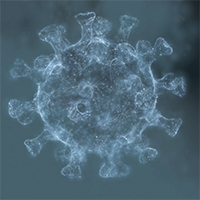Worsening of gas exchange parameters at high FiO2 in COVID-19: misleading or informative?
Keywords:
COVID-19, ARDS, shunt, pneumonia, SARS-CoV-2Abstract
Background: In COVID-19, higher than expected level of intrapulmonary shunt has been described, in association with a discrepancy between the initial relatively preserved lung mechanics and the hypoxia severity. This study aim was to measure the shunt fraction and variations of PaO2/FiO2 ratio and oxygen alveolar-arterial gradient (A-a O2) at different FiO2.
Methods: Shunt was measured by a non-invasive system during spontaneous breathing in 12 patients hospitalized at COVID-19 Semi-Intensive Care Unit of Papa Giovanni XXIII Hospital, Bergamo, Italy, between October 22 and November 23, 2020.
Results: Nine patients were men, mean age (±SD) 62±15 years, mean BMI 27.5±4.8 Kg/m2. Systemic hypertension, diabetes type 2 and previous myocardial infraction were referred in 33%, 17%, and 7%, respectively. Mean PaO2/FiO2 ratio was 234±66 and 11 patients presented a bilateral chest X-ray involvement. Mean shunt was 21±6%. Mainly in patients with a more severe respiratory failure, we found a progressive decrease of PaO2/FiO2 ratio with higher FiO2. Considering (A-a O2), we found a uniform tendency to increase with FiO2 increasing. Even in this case, the more severe were the patients, the higher was the slope, suggesting FiO2 insensitiveness due to a shunt effect, as strengthened by our measurements.
Conclusion: Relying on a single evaluation of PaO2/FiO2 ratio, especially at high FiO2, could be misleading in COVID-19. We propose a two steps evaluation, the first at low SpO2 value (e.g., 92-94%) and the second one at high FiO2 (i.e., >0.7), allowing to characterize both the amendable (ventilation/perfusion mismatch), and the fixed (shunt) contribution quote of respiratory impairment, respectively.
References
Ferguson ND, Fan E, Camporota L, Antonelli M, Anzueto A, Beale R, et al. The Berlin definition of ARDS: An expanded rationale, justification, and supplementary material. Intensive Care Med 2012;38:1573-82.
Gattinoni L, Coppola S, Cressoni M, Busana M, Rossi S, Chiumello D. COVID-19 does not lead to a “typical” acute respiratory distress syndrome. Am J Respir Crit Care Med 2020;201:1299-300.
Ackermann M, Verleden SE, Kuehnel M, Haverich A, Welte T, Laenger F, et al. Pulmonary Vascular Endothelialitis, Thrombosis, and Angiogenesis in Covid-19. N Engl J Med 2020;383:120-8.
Schaller T, Hirschbühl K, Burkhardt K, Braun G, Trepel M, Märkl B, et al. Postmortem Examination of Patients with COVID-19. JAMA 2020;323:2518-20.
Varga Z, Flammer AJ, Steiger P, Haberecker M, Andermatt R, Zinkernagel AS, et al. Endothelial cell infection and endotheliitis in COVID-19. Lancet 2020;395:1417-8.
Lowenstein CJ, Solomon SD. Severe COVID-19 Is a microvascular disease. Circulation 2020;142:1609-11.
Lang M, Som A, Mendoza DP, Flores EJ, Reid N, Carey D, et al. Hypoxaemia related to COVID-19: vascular and perfusion abnormalities on dual-energy CT. Lancet Infect Dis 2020;20:1365-6.
Sharma S, Hashmi MF, Burns B. Alveolar Gas Equation. StatPearls; Treasure Island: 2020. Available from: https://www.ncbi.nlm.nih.gov/books/NBK482268
Feiner JR, Weiskopf RB. Evaluating pulmonary function: An assessment of Pao2/Fio2. Crit Care Med 2017;45:e40-8.
Aboab J, Louis B, Jonson B and Brochard L. Relation between PaO2/FIO2 ratio and FIO2: A mathematical description. Intensive Care Med 2006;32:1494-7.
Broccard A. Making sense of the pressure of arterial oxygen to fractional inspired oxygen concentration ratio in patients with acute respiratory distress syndrome. OA Crit Care 2013;1:9.
Buoro S, Di Marco F, Rizzi M, Fabretti F, Lorini FL, Cesa S, et al. Papa Giovanni XXIII Bergamo Hospital at the time of the COVID-19 outbreak: Letter from the warfront… Int J Lab Hematol 2020;42:8-10.
Novelli L, Raimondi F, Ghirardi A, Pellegrini D, Capodanno D, Sotgiu G, et al. At the peak of Covid-19 age and disease severity but not comorbidities are predictors of mortality. Covid-19 burden in Bergamo, Italy. Panminerva Med 2021;63:51-61.

Published
Issue
Section
License
Mattioli 1885 has chosen to apply the Creative Commons Attribution NonCommercial 4.0 International License (CC BY-NC 4.0) to all manuscripts to be published.




